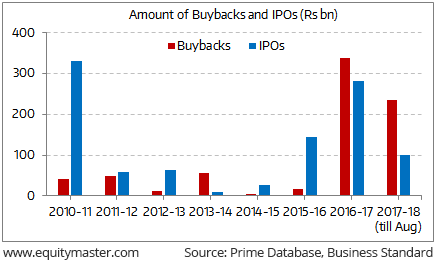- Home
- Todays Market
- Indian Stock Market News September 14, 2017
Indian Indices Trade Marginally Higher; Healthcare Stocks Witness Buying Thu, 14 Sep 11:30 am
Stock markets in India are presently trading near the dotted line with positive bias. Sectoral indices are trading on a mixed note with stocks in the healthcare sector and power sector witnessing maximum buying interest.
The BSE Sensex is trading up 50 points (up 0.2%) and the NSE Nifty is trading up 14 points (up 0.1%). The BSE Mid Cap index is trading up by 0.6%, while the BSE Small Cap index is trading up by 0.7%. The rupee is trading at 64.07 to the US$.
In the news from global financial markets, data showed retail sales and industrial output growth slowed in China during the month of August.
China's National Bureau of Statistics said the economy saw 6% annual growth in its industrial output in August. This was slower than 6.4% growth seen in July. Further, retail sales expanded 10.1% on year in August, compared with 10.4% in July. Fixed asset investments also undershot expectations.
The above data suggested that the world's second largest economy continued to cool.
Economic growth in China has been better-than-expected during the first half of this year. However, there's no surety that this would continue ahead. This we say is because most of the economic growth seen was backed by heavy government spending, rise in housing markets, and higher bank lending last year.
China is also staring at a rapid domestic credit growth. And the country's structural reforms are not enough to arrest its rising debt.
The International Monetary Fund (IMF) has again warned China over its ballooning debt crisis. The IMF recently said that China's massive debt is on a dangerous path, raising the risk of a sharp slowdown in growth.
The report by IMF stated that while China's near-term growth outlook has firmed up, it is at the cost of further large and continuous increases in private and public debt, and thus increasing downside risks in the medium term. It also warned that the country's debt load could soar from around 235% of gross domestic product (GDP) last year to more than 290% in 2022.
Note that, while the Fed's balance sheet expanded rapidly during the financial crisis, from less than US$900 billion before 2007 to US$4.5 trillion in 2014, the PBOC's balance sheet less than doubled in size during that period.
Moody's Investors Service has downgraded China's sovereign ratings by one notch to A1. The agency expects the financial strength of the world's second-largest economy to erode in coming years as growth falters and debt continues to rise.
Many economists are also of the view that central bank stimulus measures are masking the deeper problems of industrial overcapacity and high levels of corporate debt in China.
So there remain many concerns for China.
One of the recent editions of Vivek Kaul's Inner Circle (requires subscription) takes a closer look at the Chinese economy and explores how America and China are on the verge of swapping their economic ideologies.
In other news, Wipro share price is witnessing selling pressure today as the stock turned ex-date for the proposed buyback.
The company had announced September 15, 2017 as the record date for determining the entitlement and the names of equity shareholders who are eligible to participate in the buyback.
On July 20, 2017, the board of directors of Wipro had approved a buyback proposal for purchase by the company of up to 343.7 million equity shares of Rs 2 each at price of Rs 320 per share from the shareholders of the company.
Speaking of share buybacks, many buybacks are set to hit a new record this financial year. As per Prime Database, in the first five months of FY18, at least twenty companies have offered to buy back shares worth Rs 480 billion.
Also, in the past two years, the quantum of share buybacks has far exceeded the amount of new equity capital raised from IPOs.
As is evident from the chart below, so far this fiscal, India Inc has extinguished shares worth nearly Rs 235 billion through twenty buybacks - 2.3 times more than the Rs 100 billion raised by way of initial public offerings.
Buybacks Overtake IPOs
As per Rahul Shah, co-head of Research, investors should not assume buybacks are always good. Here's an excerpt of what he wrote in a recent edition of The 5 Minute Wrapup:
- The reason behind the buyback must be investigated. At the end of the day, an increase in earnings should be more a function of the inherent robustness of the business, as that's what will help it continue to grow at a healthy pace.
The topic also brings us to ask: Do buy-backs offer an arbitrage opportunity for retail investors? Ankit Shah has answered this question in a recent edition of Equitymaster Insider. You can access the issue here.
For information on how to pick stocks that have the potential to deliver big returns, download our special report now!
Read the latest Market Commentary



Equitymaster requests your view! Post a comment on "Indian Indices Trade Marginally Higher; Healthcare Stocks Witness Buying". Click here!
Comments are moderated by Equitymaster, in accordance with the Terms of Use, and may not appear
on this article until they have been reviewed and deemed appropriate for posting.
In the meantime, you may want to share this article with your friends!